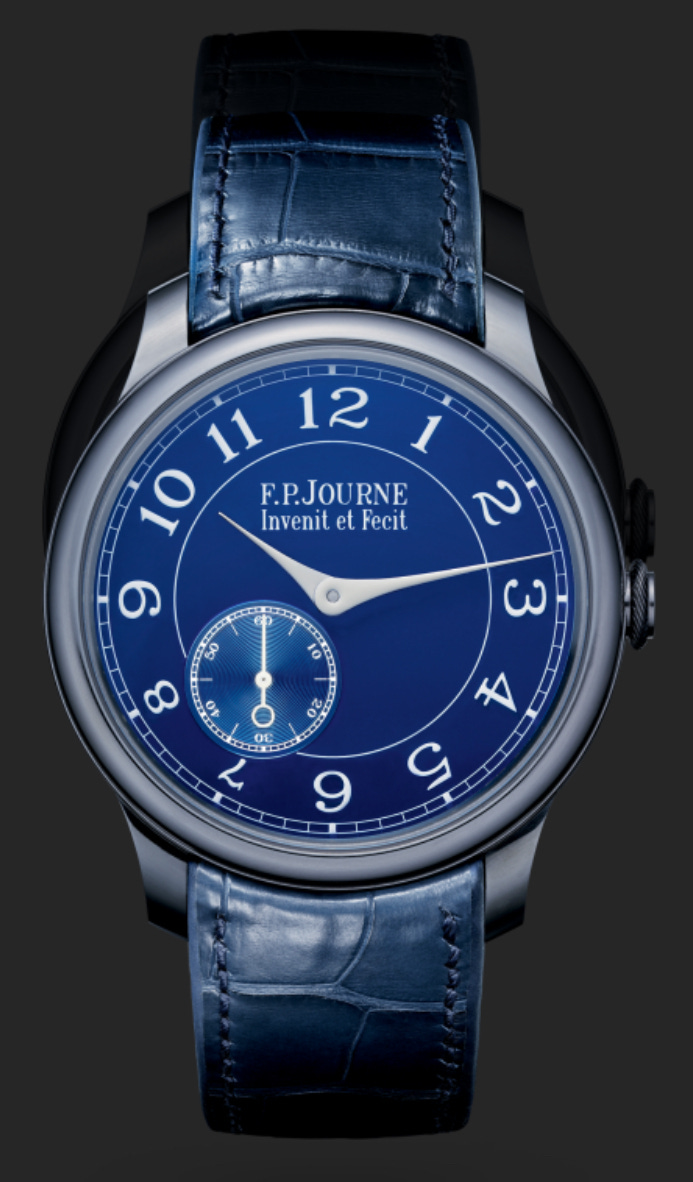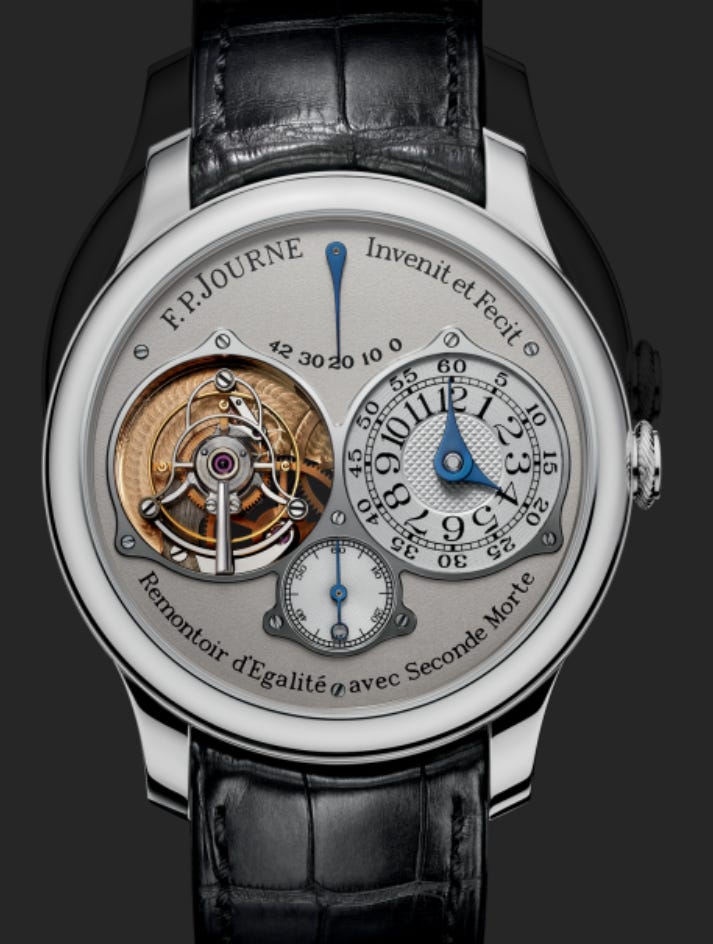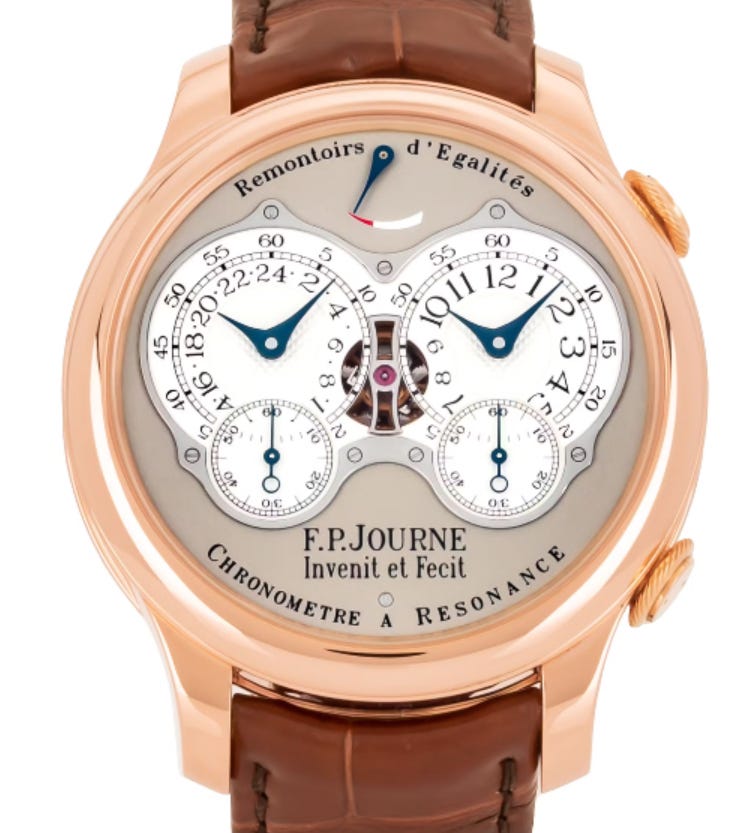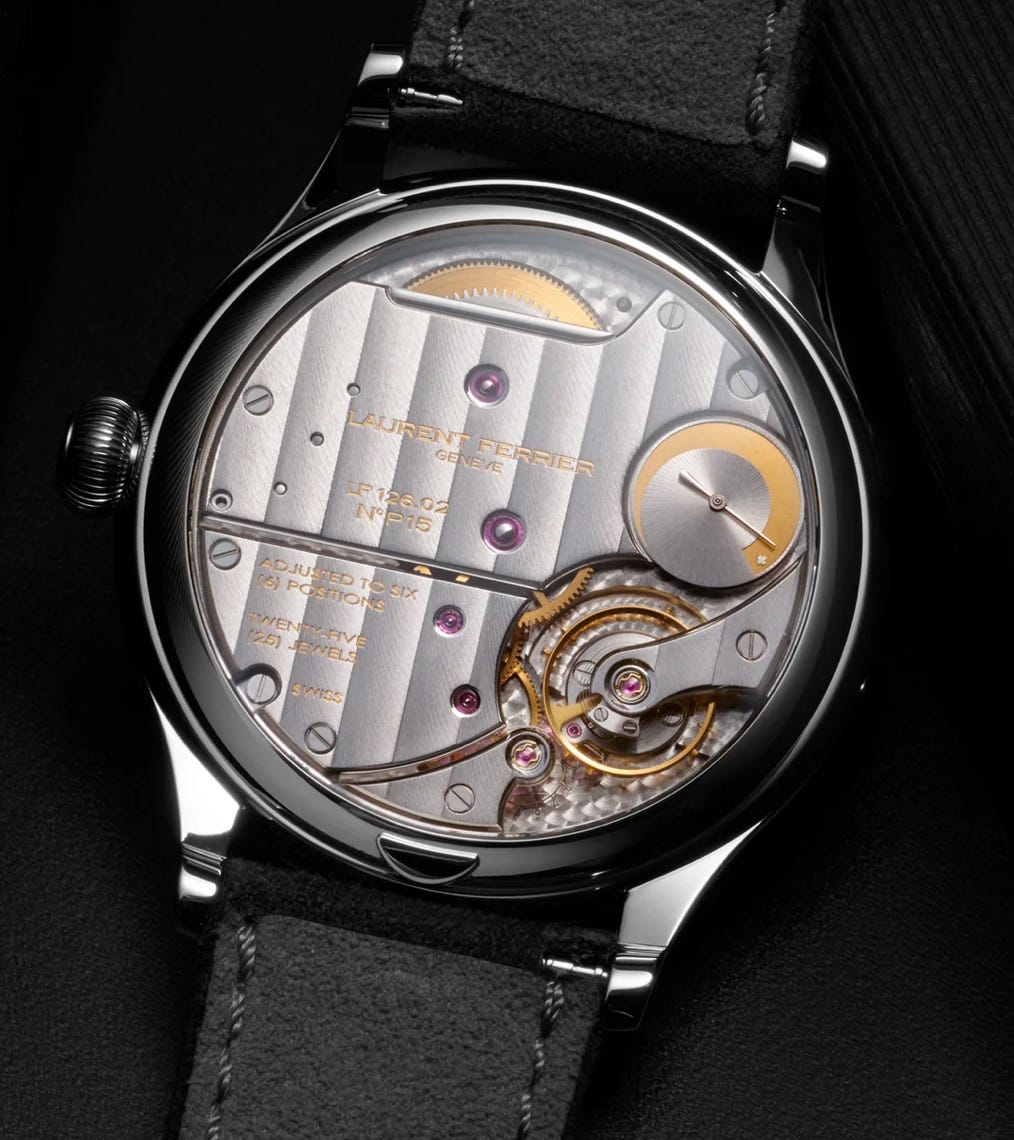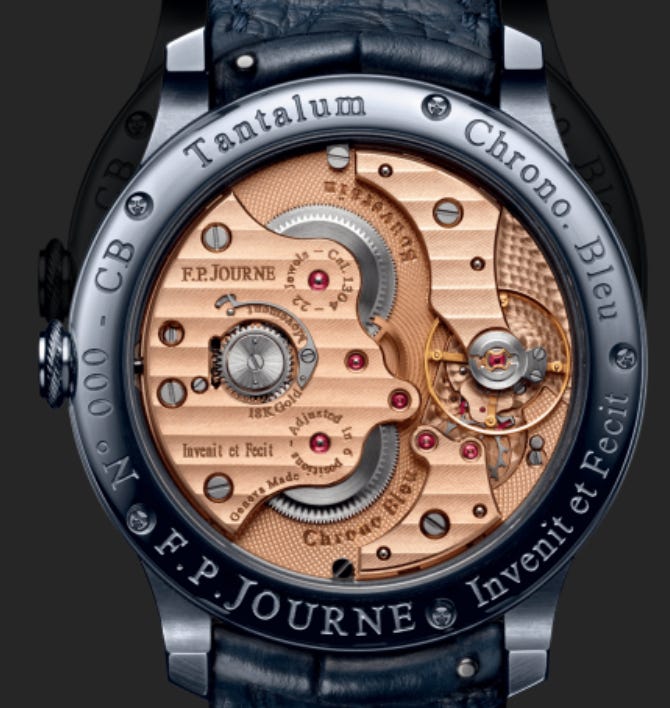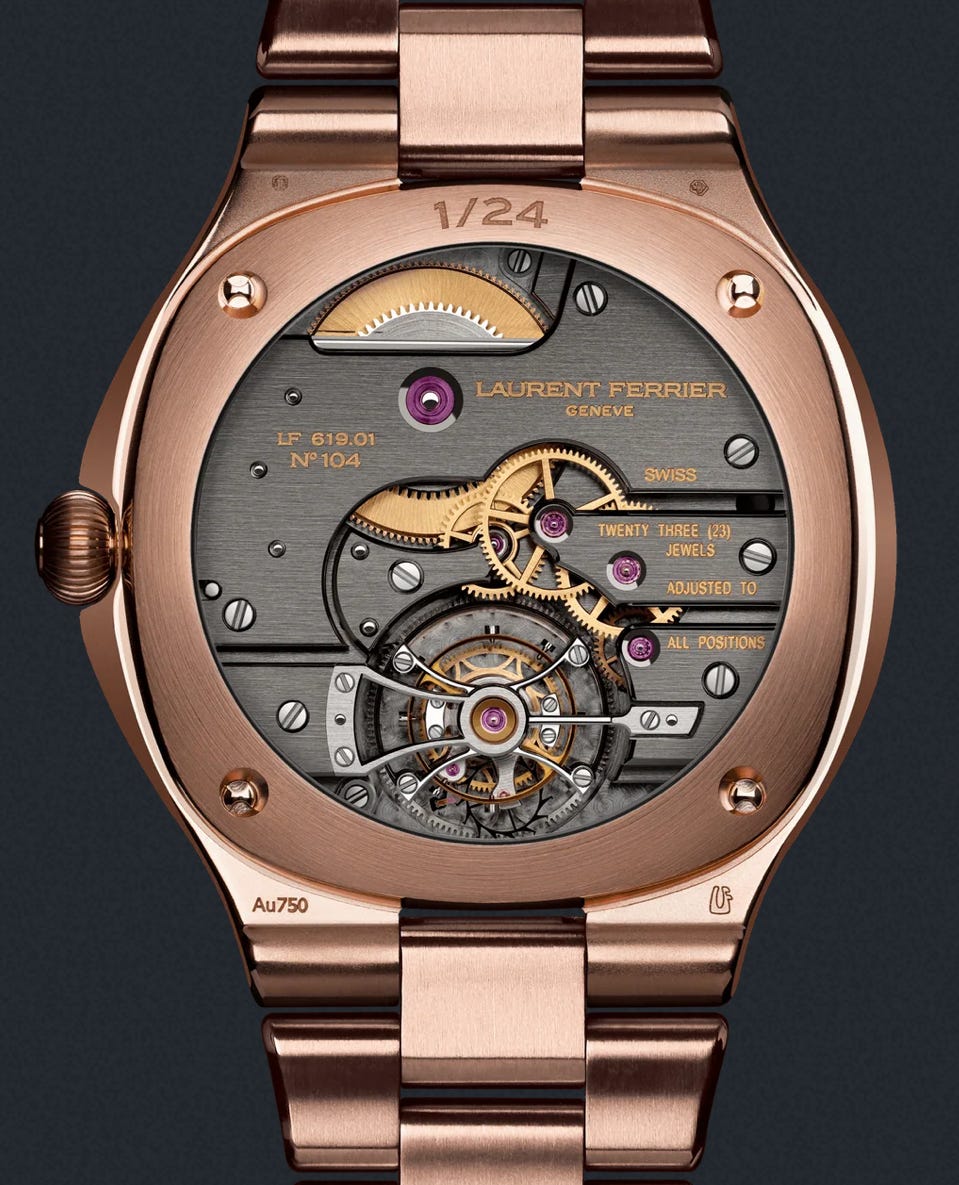In the elite world of haute horlogerie, few names resonate with the same reverence and respect as François-Paul Journe and Laurent Ferrier. Both men have forged distinctive paths within independent watchmaking, rising to the highest echelons of craftsmanship, innovation, and artistic expression. They represent more than just skilled artisans; they embody a commitment to the pursuit of perfection and the idea that watchmaking is, above all, an art form.
While Journe and Ferrier may have taken different approaches to horology, their commonalities lie in their unwavering dedication to craftsmanship and their roles as visionary creators. Unlike the large, established brands, which often emphasize historical legacy, Journe and Ferrier are pushing boundaries, creating future classics that will ultimately develop their own place in the annals of horological history.
This essay delves into their journeys, explores the key pieces that defined their legacies, examines their mastery of finishing, and considers how their brands might continue beyond their personal involvement.
The Beginnings: Journe and Ferrier’s Journeys to Independence
François-Paul Journe: A Watchmaking Visionary
François-Paul Journe’s path to horological greatness began in Paris, where he was born in 1957. His introduction to watchmaking came through his uncle, a master restorer, who provided the young Journe with his first exposure to the intricacies of fine horology. His formal education at the École d’Horlogerie de Paris equipped him with the technical knowledge he needed, but it was his work as a restorer that truly shaped his philosophy. Journe came to see watchmaking as an artistic pursuit, one that required not only technical precision but also an unyielding attention to aesthetic detail.
In 1985, Journe opened his own workshop in Paris, crafting bespoke timepieces for private clients. These early years allowed him to experiment with different techniques and complications, refining his skills as a movement designer and gaining a reputation for his ability to bring traditional watchmaking into the modern era. However, by the late 1990s, Journe felt constrained by the limitations of producing one-off pieces for individual clients. In 1999, he launched Montres Journe SA, marking the start of a brand that would soon be revered for its technical ingenuity and artistic expression.
Journe’s first wristwatch, the Tourbillon Souverain, debuted in 1999 and set the tone for the brand’s future. The combination of a traditional tourbillon with a remontoir d’égalité—an innovative constant-force mechanism—was a bold statement that Journe was not content to simply recreate the past. Instead, he sought to advance it. His personal motto, “Invenit et Fecit”(Latin for “he invented and made it”), is inscribed on every FP Journe timepiece, symbolizing his commitment to crafting watches that are both innovative and expertly made.
Laurent Ferrier: A Return to Elegance
Laurent Ferrier’s journey into independent watchmaking was deeply influenced by his decades-long career at Patek Philippe, where he worked for over 30 years, ultimately serving as technical director. Born in Geneva into a family of watchmakers, Ferrier’s early exposure to horology gave him an innate appreciation for the artistry of traditional Swiss watchmaking. At Patek, Ferrier developed a reputation for his technical prowess and an eye for detail. But as his career progressed, he yearned for something more personal—a brand that reflected his vision of elegant, understated watchmaking, rooted in tradition yet imbued with modern refinement.
In 2009, Ferrier took the bold step of leaving Patek Philippe to start his own brand. The Galet Classic Tourbillon Double Spiral, his debut piece, was introduced in 2010 and immediately established Ferrier as a master of classical watchmaking. The watch’s smooth, pebble-like case and minimalist dial concealed a technically advanced tourbillon with a double spiral hairspring, designed to improve chronometric stability. It was a watch that encapsulated Ferrier’s philosophy: timeless, elegant, and technically precise.
The name Galet—French for “pebble”—was chosen to reflect the smooth, organic curves of Ferrier’s designs. For him, a watch should not only tell time but evoke a sense of calm and balance through its tactile and visual design. His focus on subtle refinement rather than bold statements has become a hallmark of the brand, appealing to collectors who value simplicity and craftsmanship over ostentation.
Key Pieces That Launched Their Careers
FP Journe: The Tourbillon Souverain
When François-Paul Journe released the Tourbillon Souverain in 1999, it sent ripples through the watchmaking world. The watch featured a traditional tourbillon, paired with a remontoir d’égalité—a constant-force mechanism designed to ensure consistent energy delivery to the escapement. This innovation significantly improved the watch’s precision, marking Journe as a pioneer in mechanical ingenuity. The Tourbillon Souverain was more than just a technical accomplishment; it was a bold statement that independent watchmaking could produce complications on par with the giants of the industry.
The Tourbillon Souverain was also visually striking, with its dial featuring an offset display for the time and a subdial for the seconds, balanced by an exposed tourbillon at the 9 o’clockposition. The use of high-quality materials, combined with meticulous hand-finishing, made this watch an instant classic. Journe’s insistence on making his movements from solid gold added another layer of prestige, enhancing the watch’s value and uniqueness.
Laurent Ferrier: The Galet Classic Tourbillon Double Spiral
For Laurent Ferrier, the Galet Classic Tourbillon Double Spiral was the watch that defined his brand’s ethos. Introduced in 2010, it was Ferrier’s first release as an independent watchmaker and immediately showcased his mastery of blending traditional watchmaking with modern sensibilities. The watch featured a tourbillon with a double spiral hairspring—a technical feat that allowed for improved accuracy by canceling out the lateral forces that typically affect single-hairspring tourbillons.
What made the Galet Classic truly stand out, however, was its design. The smooth curves of the case, combined with its minimalist dial, created a sense of timeless elegance. Ferrier’s focus on understated beauty was evident in every detail, from the hand-polished surfaces to the flawlessly finished movement visible through the caseback. The Galet Classic was not just a technical marvel—it was a masterpiece of design, embodying the subtle sophistication that has become synonymous with Laurent Ferrier.
Mastery of Finishing: Elevating Horology to an Art
For both FP Journe and Laurent Ferrier, finishing is more than just a step in the watchmaking process—it is a defining element of their work. Each brand approaches finishing with an obsession for detail that transforms their watches from mere timepieces into works of art.
FP Journe: Bold and Technical
Journe’s approach to finishing is as innovative as his movements. His decision to craft his movements in solid 18k rose gold is not just about luxury—it serves a functional purpose by providing better stability and resistance to environmental changes. The finishing techniques applied to his movements, including anglage (beveling), perlage (circular graining), and black polishing, showcase his dedication to both tradition and technical excellence. These methods are applied not only to the visible components but also to the hidden parts of the movement, demonstrating Journe’s commitment to perfection.
A prime example of Journe’s mastery of finishing is the Chronomètre Bleu, where the cool, modern aesthetic of the tantalum case contrasts with the warm, hand-finished gold movement inside. The use of tantalum, a rare and difficult-to-machine metal, reflects Journe’s willingness to experiment with unconventional materials, while the flawless finishing of the movement speaks to his reverence for traditional watchmaking techniques.
Laurent Ferrier: Subtle and Elegant
Laurent Ferrier’s finishing is characterized by its subtlety and restraint. His watches are not designed to dazzle with bold visual statements; rather, they invite the wearer to appreciate the quiet elegance of flawless craftsmanship. The Galet Micro-Rotor, for instance, features mirror-polished surfaces that give the watch a soft, pebble-like feel in the hand. Every curve, every line is carefully considered to create a harmonious design that evokes a sense of calm.
Ferrier’s movements are finished with the same level of care. The Galet Micro-Rotor features hand-polished bevels, Geneva stripes, and graining that are applied to components visible only to those who open the caseback. This attention to detail extends to the micro-rotor itself, which is crafted with the same level of precision and artistry as the more prominent parts of the movement. Ferrier’s finishing techniques are not about making a statement—they are about achieving a level of perfection that only the most discerning collectors will appreciate.
Movement Creation: Art in Mechanical Engineering
FP Journe: Pushing the Boundaries of Horology
FP Journe is widely regarded as one of the most innovative watchmakers of his generation. His movements are not just technically impressive—they are groundbreaking. The Chronomètre à Résonance, released in 2000, is perhaps the best example of Journe’s ability to combine scientific principles with mechanical artistry. The watch uses the natural phenomenon of resonance to synchronize two oscillating balances, improving timekeeping accuracy. This concept had been theorized for centuries but had never been successfully implemented in a wristwatch until Journe made it a reality.
Another standout piece from FP Journe is the Chronomètre Optimum, which features a double-barrel system and a direct impulse escapement. This escapement reduces friction and enhances the precision and longevity of the movement. These innovations, combined with Journe’s use of exotic materials like gold and tantalum, showcase his ability to push the boundaries of traditional watchmaking while maintaining a deep respect for its history.
Laurent Ferrier: Mastering the Art of Refinement
While Journe is known for his bold innovations, Laurent Ferrier takes a more classical approach to movement creation, focusing on refining traditional horological principles. The Galet Micro-Rotor is a perfect example of this philosophy. The movement features a decentralized micro-rotor that allows for automatic winding without adding bulk to the watch. This subtle innovation preserves the watch’s slim profile while providing the benefits of an automatic movement.
Ferrier’s use of a silicon escapement in the Galet Micro-Rotor represents one of the few modern elements in his otherwise traditional approach. The silicon escapement offers frictionless movement and requires no lubrication, enhancing both the precision and durability of the movement. However, Ferrier’s use of this technology is always in service of maintaining the watch’s traditional aesthetic. His movements are a masterclass in refinement, proving that even the most established principles of watchmaking can be elevated through thoughtful engineering.
Parallels in the Journeys of FP Journe and Laurent Ferrier
Despite their differing approaches, FP Journe and Laurent Ferrier share several key parallels in their journeys toward becoming the revered independent watchmakers they are today. Both watchmakers stepped away from the security of working for established brands to pursue their own visions, a move that reflects their deep personal convictions about what watchmaking should represent.
Both Journe and Ferrier are deeply committed to traditional craftsmanship, valuing quality over quantity, and emphasizing watches as personal, artisanal objects rather than commercial products. Their watches are not mass-produced, but carefully handcrafted in small numbers, ensuring each timepiece reflects their exacting standards.
Furthermore, both men are personally involved in every aspect of the watchmaking process, from initial design to final assembly. This hands-on involvement is rare in an industry where many brands outsource production or delegate tasks to large teams. For collectors, this level of involvement is part of what makes owning an FP Journe or a Laurent Ferrier watch so special—it is not just a product, but a reflection of the watchmaker’s vision and dedication.
Defining the Differences: Journe vs. Ferrier
While FP Journe and Laurent Ferrier share a commitment to craftsmanship, their design philosophies are markedly different.
FP Journe is known for his bold, avant-garde approach to watchmaking. His watches often challenge traditional aesthetics with asymmetrical dials, daring complications, and innovative materials. The Chronomètre à Résonance and Chronomètre Bleu are perfect examples of Journe’s willingness to push the boundaries of design and technology. His watches are visually striking, making bold statements both mechanically and artistically.
Laurent Ferrier, in contrast, is the master of subtlety and timeless design. His watches are defined by their smooth curves, minimalist dials, and elegant simplicity. The Galet Classic and Galet Micro-Rotor represent Ferrier’s belief that a watch should evoke a sense of calm and balance. Where Journe’s watches are often bold and complex, Ferrier’s are understated and refined, appealing to those who value classical beauty over modern flair.
Iconic Pieces That Define Their Legacy
FP Journe:
The Chronomètre à Résonance and Chronomètre Bleu are two watches that define FP Journe’s legacy. The Chronomètre à Résonance, with its dual-balance resonance system, is a mechanical marvel that exemplifies Journe’s innovative spirit. The Chronomètre Bleu, with its deep blue dial and tantalum case, has become one of the most sought-after modern watches, blending technical excellence with artistic beauty.
Laurent Ferrier:
For Laurent Ferrier, the Galet Classic Tourbillon Double Spiral and the Galet Micro-Rotorare the watches that cemented his reputation as a master of traditional watchmaking. The Galet Classic combines technical precision with a tourbillon complication, while the Galet Micro-Rotor represents Ferrier’s ability to subtly innovate while maintaining a classical aesthetic. Both watches exemplify Ferrier’s philosophy of understated elegance and mechanical refinement.
The Role of Independent Watchmakers in Shaping the Future of Collecting
Independent watchmakers like FP Journe and Laurent Ferrier play a vital role in shaping the future of watch collecting. While the major brands are often focused on preserving their historical legacies, independent watchmakers are pushing the boundaries of what is possible in horology. For collectors, owning an FP Journe or a Laurent Ferrier is not just about possessing a finely crafted watch—it is about owning a piece of the future.
Without the visionaries like Journe and Ferrier, much of the excitement in modern watchmaking would be absent. These independent watchmakers are creating watches that will one day be seen as future classics, developing their own histories and places within the larger timeline of important timepieces. Their work represents a rejection of mass-market trends in favor of true artisanal craftsmanship.
Collectors who seek out watches from independent brands often do so because they value the personal connection between the watchmaker and the timepiece. These watches are not just products—they are reflections of the watchmaker’s vision and artistry. In this sense, FP Journe and Laurent Ferrier are shaping not only the future of watchmaking but also the future of collecting.
The Future of FP Journe and Laurent Ferrier: Life Beyond the Founders
As FP Journe and Laurent Ferrier continue to expand their brands, the question remains: what happens when the founders are no longer at the helm?
FP Journe has already begun preparing for this transition by training a new generation of watchmakers in his Geneva atelier. By passing down his knowledge and techniques, Journe ensures that his brand will continue to produce exceptional timepieces, even after he steps back. His focus on innovation and quality suggests that FP Journe will remain a leading force in independent watchmaking for years to come.
Laurent Ferrier is also preparing for the future, with his son, Christian Ferrier, taking on an increasingly prominent role within the brand. The family continuity provides a strong foundation for the future, but the challenge for Ferrier will be maintaining his artisanal approach in a rapidly changing industry. As more watchmakers turn to automation, the Ferrier brand will need to find ways to preserve its commitment to craftsmanship while remaining competitive.
Other Brands Worthy of Mentioning
While FP Journe and Laurent Ferrier are undoubtedly two of the most respected names in independent watchmaking, there are several other brands that deserve to be mentioned in the same breath, particularly in terms of sales volume, pricing, and their impact on modern horology.
One such brand is Philippe Dufour, a watchmaker renowned for his uncompromising dedication to finishing and hand-crafting each watch to the highest possible standards. Dufour’s Simplicity model has achieved almost mythical status among collectors, with limited production and an unmatched level of craftsmanship. Like FP Journe and Laurent Ferrier, Dufour’s work is revered for its traditional approach, despite his innovations in movement architecture.
Another brand to consider is Romain Gauthier, known for producing low-volume, high-end timepieces that blend modern design with traditional craftsmanship. Gauthier’s Logical One is an impressive example of mechanical innovation, with a constant-force mechanism that exemplifies the brand’s focus on precision engineering and exquisite finishing. Romain Gauthier, much like Journe and Ferrier, appeals to collectors who appreciate both technical mastery and modern aesthetics.
Lastly, Kari Voutilainen has earned a place among the top independent watchmakers, with a focus on bespoke, hand-crafted timepieces that rival those of Journe and Ferrier. Voutilainen is known for his attention to detail, particularly in movement decoration and finishing, which is considered some of the finest in the industry. His watches, often produced in very limited numbers, are a reflection of his personal artistic vision and dedication to traditional craftsmanship.
These brands, much like FP Journe and Laurent Ferrier, offer collectors a rare combination of technical innovation, artistic design, and the highest levels of craftsmanship. Their limited production numbers and focus on bespoke watchmaking place them in the same league, appealing to those who seek out watches that are more than just luxury items—they are horological masterpieces.
Conclusion: The Legacy of Two Icons
FP Journe and Laurent Ferrier have redefined the world of independent watchmaking, pushing the boundaries of what is possible while remaining deeply rooted in the traditions of horology. Their contributions to the craft go beyond technical achievements—they represent the personal vision and artistry that make watchmaking such a revered craft.
As the watch world continues to evolve, the impact of these two visionaries will be felt for generations. They have not only created some of the finest timepieces of our era but have also shaped the future of horology, inspiring new generations of watchmakers to innovate while staying true to the values of craftsmanship.
For collectors and enthusiasts alike, owning an FP Journe or Laurent Ferrier timepiece is not just about possessing a beautiful watch—it is about being part of the ongoing history of horology. Their watches will undoubtedly stand the test of time, becoming future classics that collectors will treasure for decades to come.
Thank you for reading!
*All images are from Journe and Ferrier websites*




